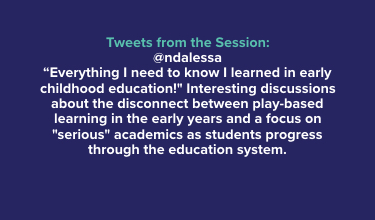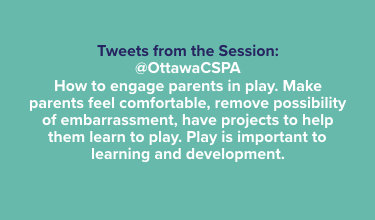Why ECE matters: developing transferable skills from the start
By Christine Schandl, Research Manager at People for Education

Everything I need to know I learned in early childhood education (ECE). That’s because ECE instructs students not only in language, cognition, logic, and numeracy, but also in social-emotional development, creativity, and other holistic areas of development. These areas may not be afforded as much time in later grades, but in ECE they are taught and assessed. In ECE, they matter.
One of the workshops at our 2018 annual conference brought together research based on the Early Development Instrument (EDI), presented by Dr. Magdalena Janus of the Offord Centre, with research and experience about the role of play in development and learning, presented by Lois Mahon, founding president of the College of Early Childhood Educators.
Dr. Janus began with some background information about the EDI and its value in child development research. Teachers administer the EDI by observing five-year old students and assessing their development in five areas:
- Physical Health and Well-being
- Social Competence
- Emotional Maturity
- Language and Cognitive Development
- Communication Skills and General Knowledge
The EDI has been administered over a million times, and is regularly administered by six provinces. EDI assessment results show that 27% of children are ‘vulnerable’ in at least one of the five domains, and that boys and children from low socioeconomic status backgrounds are more likely to be identified as ‘vulnerable’. While ‘vulnerable’ children are twice as likely to experience academic failure in grades 4 or 9, participation in preschool – even for as little as one hour per week – can reduce the likelihood of being identified as ‘vulnerable’. The EDI highlights the importance of competencies beyond literacy and numeracy for early childhood development.
 In her presentation, Lois Mahon emphasized that this holistic learning needs to continue beyond ECE. Play can be a powerful teaching tool for all areas of development, from early childhood education through elementary and high school, and even in adult learning.
In her presentation, Lois Mahon emphasized that this holistic learning needs to continue beyond ECE. Play can be a powerful teaching tool for all areas of development, from early childhood education through elementary and high school, and even in adult learning.
To demonstrate her point, Lois gave each of us a bag containing identical Lego bricks (four yellow and two red pieces), and asked us to make a duck. There was a bit of giggling and looking around to determine if she was serious, but then we got to work. I guessed that this was a way to demonstrate how much fun play can be, and how a hands-on activity can help open up conversation. It was a fun challenge: picture a duck, appraise your pieces, execute a plan, adjust as needed. When the time was up, we all put our ducks on a table.
I was surprised by the results. There were about thirty of us in the workshop, and I had expected that most people would make the same duck as me – the ‘right’ way, in my mind. But everyone created a unique duck. Lois explained that the activity demonstrates the bouquet of different approaches that can be generated by even a simple task.
Once a child moves into grade one, they are less likely to experience play in the classroom. And in subsequent grades, they are even less likely to learn through play. Lois explained that in ECE, students intentionally develop inquiry skills, creativity, and independent thinking. Then, in the later grades, the school system seems to take this away – asking students to follow stricter rules and perform more well-defined tasks. However, once students graduate, employers want them to have these entrepreneurial competencies. The question raised by this workshop is how can we bridge this gap, so that the domains assessed by the EDI and valued in ECE continue to be fostered throughout school?
 Participants left the workshop with a better understanding of the importance of social-emotional and creative development beyond ECE. This can be fostered through play-based education, inquiry, learning games, or other methods, and is vital for children, adolescents, and even adults. Further, tools like the EDI and MDI (Middle Years Development Instrument) can help us track development in these broad areas and understand what encourages (and inhibits) their development. I am hopeful for a future where competencies such as social-emotional learning, citizenship, health, and creativity are embedded and taught throughout the K-12 curriculum.
Participants left the workshop with a better understanding of the importance of social-emotional and creative development beyond ECE. This can be fostered through play-based education, inquiry, learning games, or other methods, and is vital for children, adolescents, and even adults. Further, tools like the EDI and MDI (Middle Years Development Instrument) can help us track development in these broad areas and understand what encourages (and inhibits) their development. I am hopeful for a future where competencies such as social-emotional learning, citizenship, health, and creativity are embedded and taught throughout the K-12 curriculum.
Further reading:
- See our list of transferable skills and competencies in creativity, health, citizenship, and social emotional learning.
- Learn how teaching and learning these competencies in school can improve long-term outcomes for all students and help close the equity gap.






